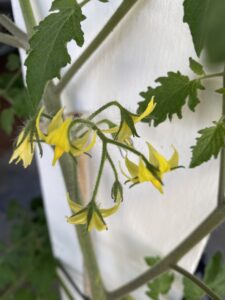
Most vegetable gardens, whether in the back yard or in pots on the balcony, feature tomatoes, cucumbers, and squash [usually the prolific zucchini]. All are easy to grow and attractive with their lush leaves and yellow flowers. I enjoy the lacy effect of these tomato blossoms in my garden.
Americans also like the taste of tomatoes and consume 22 pounds of tomatoes annually, second only to potato consumption. Eleven of those 22 pounds are consumed in ketchup and tomato sauce. Over $2 billion of commercial tomatoes are produced in the United States each year. California produces the most tomatoes processed into other products, most often canned. Florida leads in producing tomatoes for the fresh food market. One of the reasons people often say supermarket tomatoes lack flavor is because the fruits are picked while still green and ripen during transport.
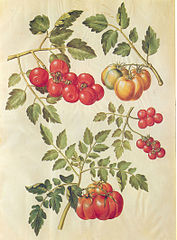
Tomatoes first grew in the Andes Mountains of Peru and Ecuador. The Aztecs called the fruit tamtl. Spanish explorers called it tomate, a word English speakers translated as tomato. Pietro Andrea Mattioli, an Italian botanist, thought the plant might be a new type of eggplant, because it could be cooked the same way in oil with salt and pepper seasoning. Mattioli called the new fruit pomi d’oro, or Golden Apples, presumably after the yellow variety.
Matthioli thought the tomato was related to mandrakes, a known aphrodisiac, which gave the fruit the alternate name Love Apple. It wasn’t until the 17th century that tomatoes found their way into Italian cooking.
Meanwhile, Northern Europeans called the new fruit a Poison Apple, because aristocrats became sick and sometimes died from eating tomatoes. We now know the accusation was a bad rap. The upper classes used flatware made from pewter which has a high lead content. Any food with a high acid content would cause the lead to be absorbed in the food, inflicting the consumer with lead poisoning and possibly death.
It is true that tomatos belong to the family of Solanum lycopersicum, which also includes eggplant and deadly nightshade. The leaves, roots, and stem of the tomato plant contain tomatine, an alkaloid that can cause gastrointestinal distress.
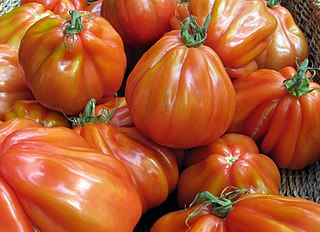
In the early 19th century tomatoes became more common in the U.S. Thomas Jefferson grew them at Monticello.
There is an anecdotal story relating to Colonel Robbert Gibbon Johnson who disregarded warnings that eating tomatoes would turn his blood to acid. In an effort to quash the warnings, he let it be known he was going to eat an entire basket of tomatoes and survive. Gibbons’ physician warned: “The foolish colonel will foam and froth at the mouth and double over with appendicitis.“ And if Gibbons managed to survive, the tomato skin would stick to his stomach and cause cancer. There’s no record that either calamity occurred.
PIZZA IS BORN
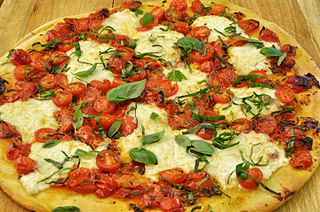
The pizza may be the greatest boost to tomato consumption. When Queen Margarite of Italy visited Naples in the 1880s, a chef created pizza to represent the colors of the new Italian flag: red tomato sauce, white mozzarella cheese, and green basil leaves. Pizza Margarite continues to be one of the most popular pizza choices.
Are tomatoes fruits or vegetables?
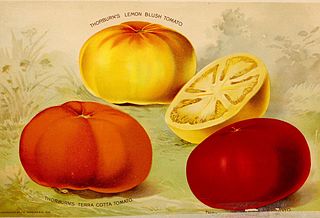
There is a continuing discussion over what, exactly, a tomato is. Is it a fruit, or a vegetable? Botanists define fruit as a fleshy material that covers a seed, which makes the tomato a fruit. At least until the 1893 U.S. Supreme Court decision in Nix vs. Hedden. In 1887 U.S. tariffs applied to imported vegetables, but not fruit. This was a matter of some concern to John Nix, founder of Nix & Co. fruit commission in New York City,
On Feb. 4, 1887, Nix filed an action against Edward L. Hedden, Collector of the Port of New York to recover duties he had paid under protest on the tomatoes he imported from the West Indies. In its decision, delivered by Justice Gray, the unanimous court noted that the only question was whether tomatoes were vegetables or fruit. Both parties cited dictionary definitions of the terms. The court ruled that “Botanically speaking, tomatoes are the fruit of a vine . . . . But in the common language of the people . . . all these are vegetables . . .usually served at dinner in, with , or after the soup, fish, or meats which constitute the principal part of the repast, and not, like fruits generally, as dessert.”
Thus tomatoes are vegetables for purposes of tariff collection. And on those grounds the tomato is the official state vegetable of New Jersey.

So, if a tomato is a vegetable, does that make tomato ketchup a vegetable? In 1981 the Reagan Administration suggested classifying ketchup as a vegetable in order to save money on the school lunch program. Officials withdrew the proposal due to public outcry.
Incidentally, the average American eats 71 pounds of ketchup every year.
🍅🍅🍅
Photos:
Tomato blossoms by Author
Tomatoes, gouache on vellum, 17th century
Heirloom tomatoes by Ruth Hartnup
Pizza Margherita by Jeffreyww
J.M. & Co. Seed Catalog. Biodiversity Heritage Library
Heintz ketchup. Life Magazine. 1923
Nix v. Hedden, 149 U.S. 304 (1893). Justia.
Tomato History. Veggie Cage.
Tomatoes. What’s Cooking America.
Heidi Lewis. “The Love Apple.” Fruit Guys. April 18, 2019.
K. Annaberlle Smith. “Why the Tomato was Feared in Europe.” Smithsonian Magazine. June 18, 2013.

Sandra Wagner-Wright holds the doctoral degree in history and taught women’s and global history at the University of Hawai`i. Sandra travels for her research, most recently to Salem, Massachusetts, the setting of her new Salem Stories series. She also enjoys traveling for new experiences. Recent trips include Antarctica and a river cruise on the Rhine from Amsterdam to Basel.
Sandra particularly likes writing about strong women who make a difference. She lives in Hilo, Hawai`i with her family and writes a blog relating to history, travel, and the idiosyncrasies of life.

